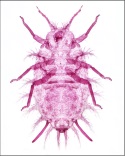Classification
Greenideinae: Cervaphidini
Diagnosis
Apterae yellow to greenish yellow, with colourless appendages. The aphids can be distinguished by the remarkably long and numerous hair-bearing processes on the body of the apterae, the marginal processes being branched, with each branch ending in a hair. In alatae, these processes are reduced (except on head) to low, flat, hair-bearing tubercles. The siphunculi are long, cylindrical, slightly curved outwards and slightly swollen subapically where there is a ring of hairs.
Generally found on flowers and flower stalks and sometimes on leaves, young shoots, or young pods of the host plant. Attended by ants. Feeding may cause flower heads to shrivel and fall off. It is difficult to detect aphid on the plant as it can be easily mistaken for scale insects because of its appearance and habit of holding on to the plant parts tenaciously.
Distribution
Known only from India (Manipur, Karnataka).
Host plant(s)
Fabaceae: Cajanus cajan (Linn.) Millsp.
Measurements
Aptera: Length of body 1.52, width 0.78; antennae 0.48, segments III: IV: 0.15: (0.06+0.09); u.r.s. 0.16; h.t.2 0.18; siphunculi 0.37.
Alata: Length of body 1.15, width 0.69; antennae 0.69, segments III: IV: V: 0.31: 0.08: (0.08+0.15); u.r.s. 0.17; h.t.2 0.07; siphunculi 0.37.
Seasonal occurrence
August-September.
Natural enemies
Coleoptera: Coccinellidae: Cheilomenes sexmaculata (F.), Coccinella septempunctata L., C. transversalis F., Coelophora bissellata Mulsant, Harmonia dimidiata (F.), H. eucharis (Mulsant), Oenopia kirbyi Mulsant, and O. quadripunctata Kapur.
_sml.jpg)

_sml.jpg)
_sml.jpg)
_sml.jpg)
_sml.jpg)
_sml.jpg)
_sml.jpg)
_sml.jpg)
_sml.jpg)
_sml.jpg)
_sml.jpg)
_sml.jpg)

